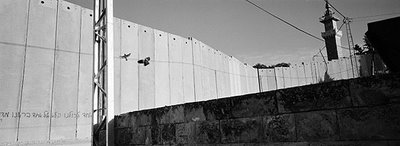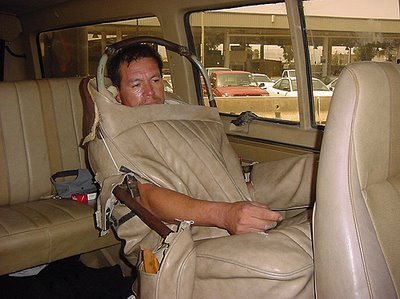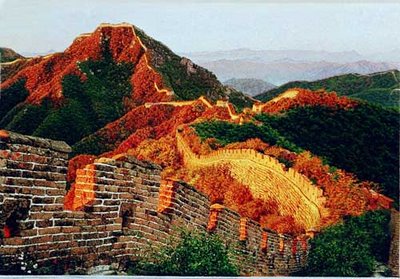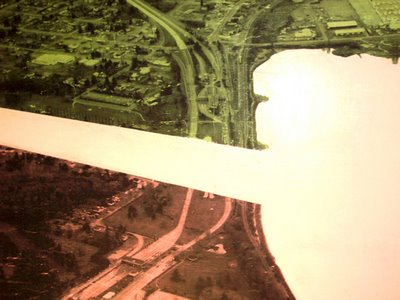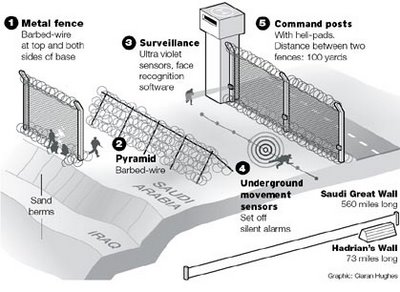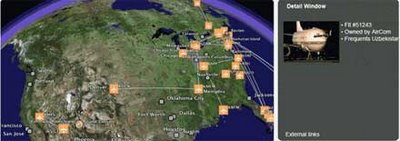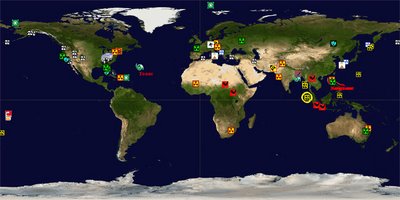 [Image: Washash, a poor district of Baghdad. Photo by Johan Spanner/Polaris, for The New York Times, Oct. 13, 2006.]MIDEASTIn Afghanistan, US troops tackle aid projects - and skepticism
[Image: Washash, a poor district of Baghdad. Photo by Johan Spanner/Polaris, for The New York Times, Oct. 13, 2006.]MIDEASTIn Afghanistan, US troops tackle aid projects - and skepticism: Money talks in Afghanistan, particularly in this undeveloped region. Whether training local police or getting tips on insurgent positions, success for US forces depends on fulfilling promises of aid and reconstruction. That's the logic behind a new fight-and-build strategy that arms the US military with millions of dollars to spend on projects to convince Afghans, one village at a time, of the benefits of opposing Taliban-led militants.
Amy Goodman interviews former Baghdad bureau chief Rajiv Chandrasekaran who has written a behind-the-scenes account of the Bush administration appointees who ran Iraq after the US invasion.Imperial Life in the Emerald City:
Inside Iraq’s Green Zone. "the more important tasks of actually rebuilding the country, of trying to find sustainable ways to increase electricity generation, to rebuild shattered hospitals and schools, to provide clean drinking water. All of those vastly more important tasks were sort of relegated, because the folks who came there saw Iraq as a terrarium for a number of neoconservative policies that they were never able to implement here in the United States."
At Checkpoints in Baghdad, Disguise Is a Lifesaving Ritual: At checkpoints set up by police or by sectarian militias, Iraqis said in interviews, it is common to hear questions such as "What is your sect?" or "What is your tribal name?" A wrong response could prove deadly. In Baghdad, it is difficult to tell a real checkpoint from a fake one. Police uniforms and badges are easily available on the black market. Shiite militiamen have infiltrated the Iraqi security forces, while Sunnis have largely remained outside them. Sunni insurgents have set up checkpoints and targeted Shiites.
Even Picking Up Trash Is a High Risk in Baghdad: In a city where a bomb could be lurking beneath any heap of refuse, and where insurgents are willing to kill to prevent them from being discovered, an occupation that pays only a few dollars a day has become one of the deadliest. Most of the 500 municipal workers who have been killed here since 2005 have been trash collectors, said Naeem al-Kaabi, the city’s deputy mayor.
Iran 'to open atomic site tours': Iran's president has ordered that the country's nuclear sites be opened to foreign tourists to prove its programme is peaceful, state media report. (via:
heathering)
Without Renewable Power, U.S. Army Could Fail in Iraq: According to a 2004 study by the Rocky Mountain Institute, more than 50 percent of all fuel consumed in the battlefield is used by support units, not frontline troops. Before the recent rise in oil prices, the U.S. Army spent some $200 million annually on fuel and paid personnel an estimated $3.2 billion to transport it. The Defense Energy Support Center reports that in 2005, the U.S. military spent around $8 billion on some 128 million barrels of fuel; in 2004, it spent $7 billion on 145 million barrels. Zilmer’s memo estimates that a hybrid solar and wind power system, though expensive initially, would cut costs by 75 percent and pay for itself in 3–5 years.
Patrolling the Shatt: Iraq has just two ports, Umm Qasr and Az Zubayr, in the south near Basra. Combined they generate 97% of the nation's revenue. Both are connected to the Persian Gulf by the polluted Shatt Al Arab waterway, which in lawless recent years has become a major artery for smugglers sneaking weapons, livestock and crude oil to and from Iran. Cracking down on these smugglers is a major priority of coalition and Iraqi forces. To this end, the Iraqi Navy patrols the Gulf end of the waterway in Rigid Hull Inflatable Boats and Fast Aluminum Boats -- that is, when they've got enough diesel fuel and spares for their boats' motors.
In Iraq, contractor deaths near 650, legal fog thickens: The war in Iraq has killed at least 647 civilian contractors to date, according to official figures that provide a stark reminder of the huge role of civilians in supporting the U.S. military.
Canada troops battle 10-foot Afghan marijuana plants: "We tried burning them with white phosphorous -- it didn't work. We tried burning them with diesel -- it didn't work. The plants are so full of water right now ... that we simply couldn't burn them," he said.
Gaza fishermen risk Israeli fire: Tens of thousands of Gazans depend on fishing, and - as their desperation has mounted - some have been putting out to sea regardless of the ban. This is an example of what a UN human rights observer recently described as "collective punishment" in the territory.
The World Is Not Enough: For a little less than an annual smoking habit, you can be briefed by Israeli spies, visit a West Bank checkpoint, tour the Lebanese frontlines, and travel in light aircraft over northern Israel.

Offshore Zionism by Gadi Algazi: How a militarized alliance of state-subsidized software firms, real-estate developers and captive Orthodox labour is forging the path of the Separation Wall in the Occupied Territories. Gadi Algazi writes a vey interesting piece for the New Left Review on using low-paid ultra-orthodox women workers in the settlement of Modi‘in Illit to annex parts of the West Bank.
Security Barrier or Segregation Wall: the Politicization of Language and the Wall as a Geopolitical Tool: As George Orwell once stated, if thought corrupts language, language can also corrupt thought, suggesting that terminology in any political discourse can be actively recruited in shaping the nature of debate and the perception of any political issue. The construction of the West Bank barrier in the Occupied Palestinian Territories (OPT) is one of the most controversial and hotly debated issues in the Palestinian-Israeli conflict. Since the beginning of the wall’s construction in 2002, a whole range of terminologies have emerged reflecting the opposing perspectives on the wall’s fundamental purpose.
THE ARCHITECTURE OF POLITICS (CASE STUDY 'THE WALL') by Eyal Weizman: If the politics of architecture describe the mechanisms by which social, economic, national, and strategic forces solidify into the organization, form, and ornamentation of homes and cities, then the architecture of politics could describe the spatial organization of public action. Politics is carried out through the imagination, representation, construction, organization, transformation, erasure, and subversion of space. Space is thus not formed as a consequence of politics, but is the very medium within which politics is conducted.
OTHER RANDOM MILIT_URBSDave Zweifel:
Fortress America is an ugly America (a recap of recent Blair Kamin article): "Capitol Hill is a zone of fear, welcoming the tourists with fences, slanted concrete barriers, steel walls that pop out of the pavement and steel posts called bollards that are designed to hold a vehicle-delivered bomb at bay," he wrote. "To visit here now is to realize that America has entered a new phase, in which various arms of the federal government have started replacing the temporary security measures installed in the aftermath of Oklahoma City and Sept. 11 with permanent ones."
 [Image: Gothamist reader David Shulman spotted a stealth bomber doing a little recon over Manhattan.]
[Image: Gothamist reader David Shulman spotted a stealth bomber doing a little recon over Manhattan.]With that said,
an armed man crashed into the capitol barricade not long ago. Some weirdo. After that, however, some
stealth bombers were seen swooping over Manhattan. Though, many of
New York's security barriers are being removed: So far, barriers have been removed at 30 buildings out of an estimated 50 to 70 in the city. Officials, claim many of the barriers actually posed more risk than protection. A planter struck by a car would send shards of broken pieces into the air, and thus the bollard ceases to become defensive and now "weaponized". And irony wins again.
Tobyhanna Army Depot environmentalists believe they are
the first to plant a garden on the roof of a Department of Defense building. Workers spent seven days covering the roof of one wing with about 1,500 pre-planted modules. The modules can be moved for future repair work as needed.
Also:
more on the
SkyBuilt.
Ottawa sanctioned gunfire on Great Lakes: Deal inked in 2003 with Washington Allows armed drills by U.S. Coast Guard, that means Canadians my soon have to deal with U.S. military patrols along their border polluting the lakes with the ammunition from their drills. But not without some
strong criticism.
Anti-Crime Program Provides 'Vaccination' Against Violence: Developed by a university professor, the CeaseFire campaign addresses violent crime as a public health issue, and uses a neighborhood-wide information and outreach campaign to help curb violent behavior before it occurs.
Architectural Evidence of War Crimes: Last week in the Hague, the UN war crimes tribunal found former Bosnian Serb leader, Momcilo Krajisnik, guilty of crimes against humanity based partly on the evidence of an expert in Ottoman architecture. Eleanor Hall spoke with Dr Andras Riedlmayer, the Director of Islamic Architecture at Harvard's Fine Arts Library, who has documented (pdf) the destruction of churches, mosques and libraries during the Bosnian Serb war.
 [Image: Pruned wonders if the intelligence community has gotten Yongbyon all wrong.]FROM THE BLOGGY-BLOGSClimate Ghettos
[Image: Pruned wonders if the intelligence community has gotten Yongbyon all wrong.]FROM THE BLOGGY-BLOGSClimate Ghettos :
Advertisement: Crowd Dynamics Ltd. :
Yongbyon Family ComplexThe RingArmy "Big Brother" Unit Targets Bloggers"a dark tale of globalization"ARCHIS R.S.V.P EVENT 10: Beirut UnbuiltPolice demolishing shanties in BeirutProperty Rights in Favelas?Polemos, policeIllegals Want to Hurt Your DogsGhost Lab











